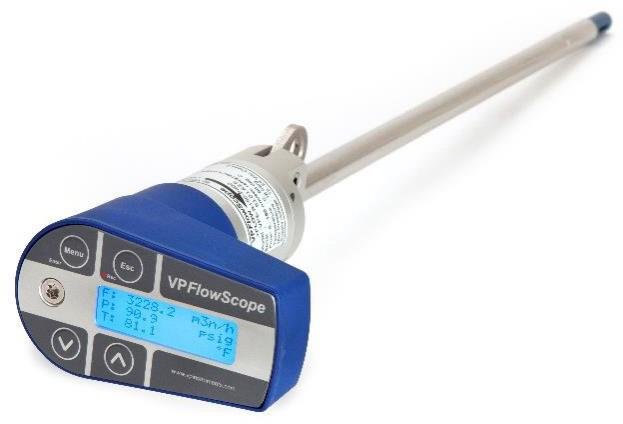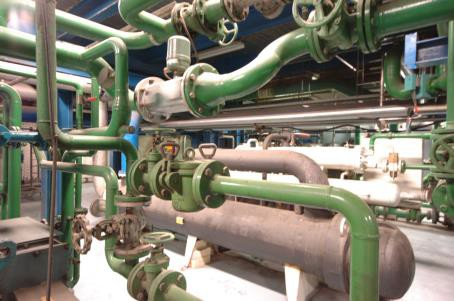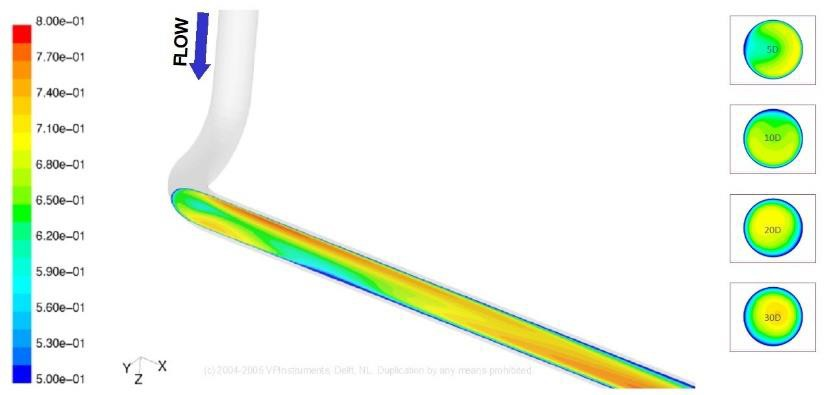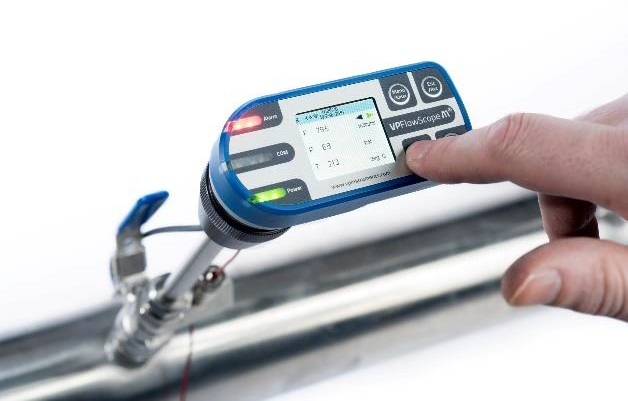On the field accuracy of flowmeter
 Release date:2023-04-03 Traffic volume:718
Release date:2023-04-03 Traffic volume:718
On the field accuracy of flowmeter
When it comes to the accuracy of flowmeters, it's important to have some basic knowledge and be able to understand what affects it. We've seen a lot of discussion on social platforms where people have commented on the accuracy without actually telling the real story. In this article, we will provide you with practical answers to some common questions.

In some discussions about flowmeters, we see the expression
For example: "With our flowmeter, you only need 10 to 15 times the upstream section
Diameter ". In fact, it's not possible.
Use a "single point" flowmeter to measure compressed air or gas in points. It's against
Its basic physical properties.
So what is a "point measurement/single point" flowmeter?
These meters are based on velocity measurements at one point to calculate the flow rate. An obvious example is the plug-in flowmeter, which is one of the most commonly used flowmeter types in the audit. Another example, less obvious from the outside, is the ultrasonic clamp measuring instrument. This flowmeter can also measure the flow rate in a straight road. Some meters measure flow using more advanced technology, such as dual path, or even multi-path, but these are less commonly used in compressed air applications.
Field accuracy vs. specifications
Field accuracy
In compressed air applications, even the most accurate flow meter can be misapplied, which may result in large systematic errors or random erratic readings. In compressed air flow audits, especially in old, existing compressed air systems, obtaining realistic measurement data can be a very tricky
thing, as all “spot measurement type” flow meters are prone to up- and downstream disturbances. These disturbances are often causing large deviations.
In compressed air applications, even the most accurate flowmeters can be misapplied, which can lead to large systematic errors or random unstable readings. In compressed air flow audits, especially in older, existing compressed air systems, obtaining true measurements can be very tricky.
All "point measuring" flowmeters are susceptible to both upstream and downstream interference. These disturbances often cause large deviations.
Examples of items that can disturb the flow profile are double elbows, abrupt diameter changes, and large T-pieces. In many cases, the customer can only place the flow meter 5 or 10 diameters downstream of these items, which will have a large influence on the field accuracy.
Examples that may interfere with flow profiles are double bends, sudden diameter changes, and large T-ports. In many cases, customers can only place flowmeters in 5 or 10 diameter sections downstream of these projects, which can have a significant impact on field accuracy.

The perfect installation spot in existing factories is often a challenge.

A flow meter is calibrated under ideal conditions, which means it will be subjected to a known, symmetric velocity profile in a reference pipe with known inner diameter. But when you have to install a flow meter in a pipe on a too
short distance from potential disturbances we advise you to add at least 5% to 10% to your uncertainty budget and make sure all parties involved are aware of the additional measurement uncertainty. Especially when “testing” compressor performance in the field, one needs to be very careful.
The flowmeter is calibrated under ideal conditions, which means that it will be subject to a known, symmetrical velocity profile in a pipe with a known internal diameter. But when you have to install a flowmeter on a short upstream and downstream section
We recommend that you add at least 5% to 10% to the uncertainty error and ensure that all interested parties are aware of the additional measurement uncertainty. Especially when "testing" compressor performance in the field, great care needs to be taken.
Turbulent vs. Laminar
Turbulent flow and laminar flow
We still hear people talking about "laminar flow" in compressed air. Let’ s get this straightened out as well. Did you know that compressed air, due to the high velocities and large pipes, is always turbulent? In compressed air networks, you will never reach laminar flow unless you are measuring very low velocities. Why? Because of another law of Physics, which is described by Reynolds and
others. But don’ t worry, it is not a problem at all. It actually has an advantage, as the flow profile is
rather flat instead of parabolic. Which makes insertion of your flow meter less critical in larger pipes.
We still hear people talk about "laminar flow" in compressed air, so let's get that clear, too. Did you know that compressed air, with its high speed and big pipes, is always turbulent? Laminar flow is never achieved in a compressed air network unless very low velocities are measured. Why? Because another law of physics, described by Reynolds et al. But don't worry, that's not a problem at all. It actually has an advantage because the flow curve is fairly flat and not a parabola. This makes the use of plug-in flowmeters in larger pipelines less intrusive.
From now on, we should talk about "fully developed" flow instead of laminar, which means the flow profile is nicely symmetric, equally distributed over the pipe surface. It will take quite some length to become symmetric, in some cases, especially with double elbows out of plane, we have seen that it takes up to 60 D.
From now on, we should talk about "fully developed" flows, not laminar flows, which means that the flow profile is very symmetrical and evenly distributed across the pipe surface. It requires quite long straight pipe lengths to be symmetrical, and in some cases, especially in some double bend cases, we have seen that 60 times the diameter is required to form a fully developed flow rate.
Flow meter technologies compared – things to be aware of
Flowmeter technology comparison - things to note
Thermal insertion probes: flow profile effects and temperature effects. Sudden changes in temperature can influence the measurement. Water drops will give spikes in the measurement signal.
Thermal mass insertion probes: Flow profile and temperature effects. Sudden changes in temperature can affect measurements. Water droplets create spikes in the measured signal.
Differential pressure probes: flow profile, turndown ratio is limited, be aware of low flow. Water drops and dirt might clog pressure ports. Water in connecting pipework can give strange results.
Differential pressure probe: flow profile and regulation ratio is limited, need to pay attention to low flow. Water and dirt may clog the pressure ports. The water connected to the pipes could have an impact on the results.
Ultrasound: Flow profile, ultrasonic noise from valves, vibration, signal loss.
Ultrasonic: Flow profile, valve ultrasonic noise, vibration, signal loss.
Vortex (in-line): Water drops, turndown ratio is limited, be aware of low flow and permanent pressure loss over the meter
Vortex street (online): Water drop, limited regulation ratio, low flow and pressure loss should be paid attention to.
Differential pressure (in line): Limited turndown, be aware of low flow. Permanent pressure loss when using orifice type meters.
Differential pressure (pipe type): limited regulation ratio, low flow needs attention. There is a permanent pressure loss when using orifice - plate meters.
Turbines: Oscillation can give higher or lower average flow values. Pressure pulses might damage the bearings. Water can cause corrosion, causing misreadings.
Turbines: Oscillations may give higher or lower average flow values. Pressure pulses may damage bearings. Water can cause corrosion, leading to false readings.
How accurate do you need to be?
How accurate do you need to be?
In an audit, it depends on what you are looking for (leaks, demand profile, compressor control system performance, compressor efficiency). When analyzing the data, it is all about the auditor skills, and how the auditor interprets the combination between various sensors and signals.
In an audit, it depends on what you are looking for (leaks, demand profile, compressor control system performance, compressor efficiency). When analyzing data, it is the skill of the auditor and how the auditor interprets the combinations between the various sensors and signals.
Sometimes, a simple load/unload signal of a compressor can already provide insight in the control system behavior, in other cases you might want to zoom into the demand side, where you need a bi- directional flow meter. The more signals you combine, the more clarity you will get about what is going on exactly.
Sometimes a simple load/unload signal from an air compressor can already provide insight into the behavior of the control system, in other cases you may want to scale up to the demand side where you need a two-way flowmeter. The more signals you combine, the clearer you'll be about what's going on.
In general, 5% accuracy is fine for an air audit using insertion probes, taken all uncertainties into account. If you want to test a compressor in the field, and compare it to factory specs, you must check the ISO 1217 directive on the required accuracy. This might require special equipment and specialized people to carry out the test.
In general, 5% accuracy is good for an air audit using a plug-in flowmeter, given all the uncertainties. If you want to test the compressor in the field and compare it to factory specifications, you must check the accuracy required by the ISO 1217 directive. This may require specialized equipment and professionals to perform the tests.
Need some advice?
Need some advice?

Contact us to discuss your application. We will be happy to advise you with selecting the right product, which might not be a flow meter in some cases.
Contact us to discuss your application together. We will be happy to choose the right product for you.
- Previous article:Measurement principle of KPI for compressed air system
- Next article:The importance of bidirectional compressed air flow measurement
For domestic enterprises of green energy conservation
Industry makes its own contribution
By searching on the website, you will receive the latest information on industry trends and developments, our products and solutions,
And information about our trade fair.


